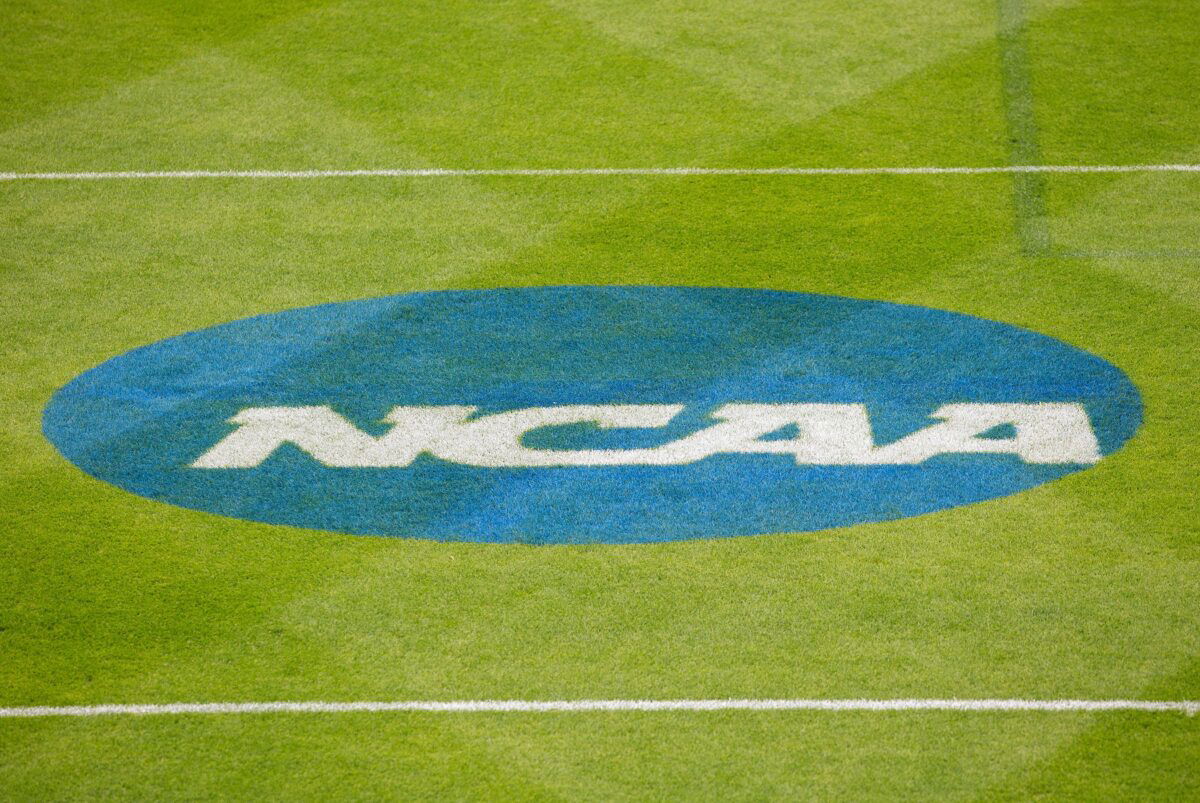
Imago
EAST HARTFORD, CT – MAY 19: General view of the NCAA, College League, USA logo prior to the Division 1 quarterfinal game between Loyola Greyhounds and Penn State Nittany Lions on May 19, 2019, at Rentschler Field in East Hartford, CT. (Photo by M. Anthony Nesmith/Icon Sportswire) NCAA LACROSSE: MAY 19 NCAA Lacrosse Championships Quarterfinals – Loyola v Penn State PUBLICATIONxINxGERxSUIxAUTxHUNxRUSxSWExNORxDENxONLY Icon19051913

Imago
EAST HARTFORD, CT – MAY 19: General view of the NCAA, College League, USA logo prior to the Division 1 quarterfinal game between Loyola Greyhounds and Penn State Nittany Lions on May 19, 2019, at Rentschler Field in East Hartford, CT. (Photo by M. Anthony Nesmith/Icon Sportswire) NCAA LACROSSE: MAY 19 NCAA Lacrosse Championships Quarterfinals – Loyola v Penn State PUBLICATIONxINxGERxSUIxAUTxHUNxRUSxSWExNORxDENxONLY Icon19051913
A 5-star firecracker lit up Texas Tech’s Fourth of July. And it came from Felix Ojo, the No. 1 player in the state of Texas and a top-10 national recruit in the 2026 class. He chose the Red Raiders over Texas, Ohio State, and pretty much everyone else. And the real detonation came from the word that his commitment came attached to a revenue-sharing agreement. Some say it’s a three-year $5.1 million deal. Others say it’s $2.3 million. Either way, it’s not NIL nor some shady third-party collective. This money is reportedly straight from the university’s capped revenue-sharing pot ushered in under the NCAA v House settlement.
Watch What’s Trending Now!
Welcome to the new era of college football where August 1 is about to become as important as National Signing Day. That’s when schools can start putting revenue-share contracts in writing for rising high school seniors. No more vague NIL promises or secret backdoor deals. As On3 NIL reported on X on July 10, “An SEC general manager speculated to @PeteNakos_ that another conference school is allocating $15 million toward its 2026 recruiting class. ‘How can they pay that?’” That question is now at the heart of everything.
How can schools balance massive football contracts with the pressure to field full athletic departments? Turns out, many can’t. Look no further than USC where budget cuts are slashing more than just scholarships. Six athletic department staffers, including longtime exec Paul Perrier, were let go. Another six vacancies were also gone. And that’s because the Trojans plan to distribute the full $20.5 million revenue-share cap in 2025, most of it to football.
ADVERTISEMENT
An SEC general manager speculated to @PeteNakos_ that another conference school is allocating $15 million toward its 2026 recruiting class💰
“How can they pay that?”
Read: https://t.co/YHcFOiNqJo pic.twitter.com/w0ElE6gFFo
— On3 NIL (@On3NIL) July 10, 2025
Even athletic departments with oil-rich boosters aren’t immune. Texas Tech has been aggressive thanks to billionaires Cody Campbell and John Sellers, guys who turned NIL into an arms race, but now the money pipeline must navigate a regulated system. No more free-for-all. There’s a $20.5 million ceiling and a Deloitte-run clearinghouse watching every deal over $600. The Red Raiders struck gold with Felix Ojo, but questions linger. Is this sustainable? Is it worth it? Can they replicate this success annually within a capped system? Because many programs are already recognizing the dangers.
ADVERTISEMENT
How schools are faring under the NCAA revenue sharing
Across the landscape, Olympic sports are getting the axe. Since the House settlement, schools have cut 32 Division I programs. Schools like St. Francis dropped entire divisions. Louisiana Monroe, Washington State, and UTEP are all slicing sports like track and women’s tennis. Blame it on the same villain, which is revenue sharing and roster caps. But in other programs like Ole Miss, the vibe is different. “We’re nowhere close to that right now. It’s not even in the discussion,” AD Keith Carter said.
ADVERTISEMENT
Meanwhile, schools like Iowa State have committed to splitting the budget equally between all their departments, drawing speculation. Then there’s UCF’s Terry Mohajir, who is sprinting toward full-share Big 12 membership and trying to balance the books as he goes. “We’ll become full-share members, but we have a lot more other expenses we have,” he said, adding they’re piecing together revenue streams to make it happen. But yeah, the revenue-share era is here. It feels more like the NFL every day with salary caps, spending limits, and front-office strategy replacing booster chaos. The programs that adjust fast will feast. The ones that don’t can expect more cut sports and heartbreaks.
Top Stories
NFL Makes Punishment Decision on Josh Allen Incident

Tiger Woods Gives Fan 1-Word Reply About PGA Tour Comeback Amid Leaked Schedule

Aryna Sabalenka Caught off Guard As Ball Kid Delivers Stunning Feat at Match-Point

Paige Spiranac Rubs Salt in Colt Knost’s Wounds With Latest Comments on His Amateur Golf Dreams

NFL Makes Punishment Decision Against Cowboys on Chiefs’ Incident in Thanksgiving Game

Sophie Cunningham’s Sharp Response Divides WNBA Fans Amid Caitlin Clark’s Project B Decision

ADVERTISEMENT
ADVERTISEMENT
ADVERTISEMENT

